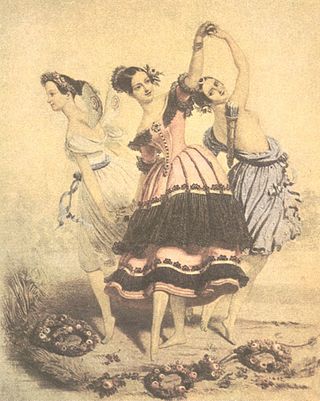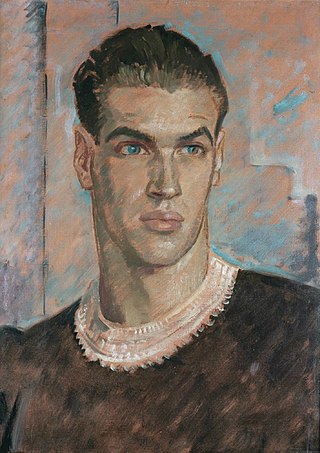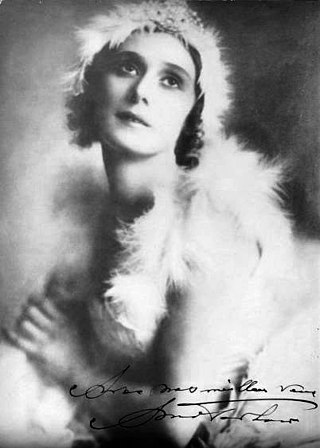Related Research Articles

The Romantic ballet is defined primarily by an era in ballet in which the ideas of Romanticism in art and literature influenced the creation of ballets. The era occurred during the early to mid 19th century primarily at the Théâtre de l'Académie Royale de Musique of the Paris Opera Ballet and Her Majesty's Theatre in London. It is typically considered to have begun with the 1827 début in Paris of the ballerina Marie Taglioni in the ballet La Sylphide, and to have reached its zenith with the premiere of the divertissement Pas de Quatre staged by the Ballet Master Jules Perrot in London in 1845. The Romantic ballet had no immediate end, but rather a slow decline. Arthur Saint-Léon's 1870 ballet Coppélia is considered to be the last work of the Romantic Ballet. Romantic ballet is believed to have been experienced in three main phases: The zenith phase from 1830-1840, the decline phase from 1850-1880, and the revival phase in the 1890s prior to Diaghilev. Each phase is synonymous with the production of a few specifically stylized ballets.

Les Ballets Trockadero de Monte Carlo is an all-male drag ballet troupe that parodies the conventions of romantic and classical ballet. The company's current artistic director is Tory Dobrin.

André Eglevsky was a Russian-born ballet dancer and teacher who studied in France and, from 1932, danced with Colonel W. de Basil's Ballet Russe de Monte Carlo for several years, as well as other companies in Europe and New York City. He became a United States citizen in the late 1930s and danced with the American Ballet Theatre and New York City Ballet. After retiring from performance in 1958, he set up his own ballet school and the Eglevsky Ballet Company in New York.
Tory Dobrin is the artistic director of the American all-male Les Ballets Trockadero de Monte Carlo. He first joined the Trocks in 1980 as a dancer.
Baby ballerinas is a term invented by the English writer and dance critic Arnold Haskell to describe three young dancers of the Ballets Russes de Monte-Carlo in the early 1930s: Irina Baronova (1919–2008), Tamara Toumanova (1919–1996), and Tatiana Riabouchinska (1917–2000).

The Dying Swan is a solo dance choreographed by Mikhail Fokine to Camille Saint-Saëns's Le Cygne from Le Carnaval des animaux as a pièce d'occasion for the ballerina Anna Pavlova, who performed it about 4,000 times. The short ballet follows the last moments in the life of a swan, and was first presented in St. Petersburg, Russia in 1905. The ballet has since influenced modern interpretations of Odette in Tchaikovsky's Swan Lake and has inspired non-traditional interpretations as well as various adaptations.

Stars and Stripes is a neoclassical ballet choreographed by George Balanchine to music by John Philip Sousa, orchestrated by Hershy Kay. The ballet was made as a tribute to the United States, Balanchine's adopted country. It premiered on January 17, 1958, at the City Center of Music and Drama, danced by the New York City Ballet. It is dedicated to Fiorello La Guardia, former mayor of New York City. The ballet had been revived by multiple ballet companies, and at different special occasions.
Kyra Nichols is an American retired ballet dancer and teacher. She joined the New York City Ballet in 1974 and was promoted to principal dancer in 1979. She is one of the last dancers to have worked with George Balanchine, although he did not create any new work on her. However, she originated roles in several ballets by Jerome Robbins. Nichols retired from performing in 2007, after a 33-year career.
Lawrence Rhodes was an American premier dancer, dance teacher and director of ballet companies and the dance divisions of New York University and the Juilliard School.

Aesha Ash is an American ballet dancer and teacher. She danced numerous leading roles as a member of New York City Ballet's corps de ballet and as a soloist with Béjart Ballet and Alonzo King LINES Ballet, and Morphoses/The Wheeldon Company. Following her retirement from performing, she founded The Swan Dreams Project in 2011 to dispel stereotypes about Black women in ballet. In 2020, she became the first African American female faculty member at the School of American Ballet.
Chase Johnsey is an American ballet dancer. He is the co-founding and current Artistic Director of Ballet de Barcelona. He was a former principal dancer with Les Ballets Trockadero de Monte Carlo and a former first artist with the English National Ballet. Johnsey, who identifies as genderfluid but uses he/him pronouns, is reportedly the first male dancer to join the female ensemble of an international ballet company.

Brooke Lynn Hytes is the stage name of Brock Edward Hayhoe, a Canadian-American drag queen, ballet dancer, and television personality. After working as a dancer with Cape Town City Ballet and Les Ballets Trockadero de Monte Carlo, Brooke Lynn Hytes achieved international recognition for competing on the eleventh season of RuPaul's Drag Race; Brooke Lynn Hytes placed second, only to winner Yvie Oddly. Brooke Lynn Hytes is the first Canadian to compete in the series. Since 2020, Brooke Lynn Hytes has been a main judge on the spin-off series Canada's Drag Race, and is the first Drag Race contestant to become a full-time judge in the franchise.
Rebels on Pointe is a Canadian documentary film, directed by Bobbi Jo Hart and released in 2017. The film centres on the drag ballet troupe Les Ballets Trockadero de Monte Carlo.
Georgina Pazcoguin is an American ballerina. She was a soloist with the New York City Ballet, and is known for challenging racism in ballet, and for performing on Broadway.
Sabrina Sophie Pretto is an Italian ballet dancer. She was formerly a soloist with Les Ballets Trockadero de Monte Carlo ballet company. She was previously a company member with Stadtheater Koblenz and Les Ballets Grandiva, and danced as a guest artist with English National Ballet and Fondazione Arena of Verona. Pretto was a finalist in an international shoe design contest in 2000, organized by Sammauro Industria, and launched a dancewear line called Albypretty.
Catherine Hurlin is an American ballet dancer. She joined the American Ballet Theatre (ABT) in 2014 and was promoted to principal dancer in 2022.

Unity Sickles Phelan is an American ballet dancer. She joined the New York City Ballet in 2013 and was promoted to principal dancer in 2021. Outside of the company, she had also danced in films John Wick: Chapter 3 – Parabellum and I'm Thinking of Ending Things.
Indiana Woodward is a French ballet dancer. She joined the New York City Ballet in 2012, and was promoted to principal dancer in 2021.
Black women have been traditionally underrepresented in ballet. In the 15th and 16th centuries, ballet began in Italian Renaissance courts, where it was largely dominated and influenced by the aristocracy. Ballet later spread to France and was developed under Louis XIV. After the first professional theatrical ballet company, the Paris Opera Ballet, was established in 1669, ballet spread throughout Europe and the rest of the world. Ballet eventually arrived in the United States, and by 1933, the San Francisco Ballet, the first professional ballet company in the United States, was founded.
References
- 1 2 3 4 5 6 7 Les Ballets Trockadero de Monte Carlo official website. Retrieved December 26, 2008.
- 1 2 3 4 5 6 7 8 9 10 Finis Jhung, "Interview with Robert Carter", found at Dance Art website. Retrieved December 26, 2008.
- 1 2 3 4 5 6 7 Rachel Straus, "Men On Pointe," Dance Spirit magazine, April 1, 2008, found at Dance Spirit website. Retrieved December 26, 2008.
- 1 2 3 4 5 6 7 Nightline staff, "Meet the Trocks: Men, Tutus and Talent: Les Ballets Trockadero de Monte Carlo Have Entertained for More Than 30 Years," found at ABC News website. Retrieved December 29, 2008.
- 1 2 3 Jennifer Dunning, "Ballet Review: Beyond Satire, With Daring Feats," August 19, 1998, The New York Times , found at New York Times website. Retrieved December 29, 2008.
- 1 2 "Robert Carter, the company’s unofficial fouetté queen, whips off dozens of turns in this tutu dreamland as Olga Supphozova." Gia Kourlas, "Dance Review: Les Ballets Trockadero de Monte Carlo: Heroines of Ballet, Heroically Funny," The New York Times , December 22, 2008, found at New York Times website. Retrieved December 29, 2008.
- 1 2 3 Sanjoy Roy, "Dance: Les Ballets Trockadero de Monte Carlo: Peacock Theatre, London," (4 stars out of 5), 22 September 2006 found at The Guardian website. Retrieved December 29, 2008.